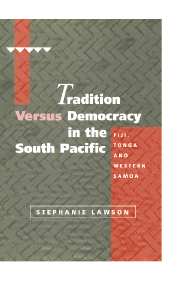Book contents
- Frontmatter
- Contents
- List of Maps
- List of Tables
- Preface
- Epigraph
- The South Pacific
- Introduction
- Chapter 1 Tradition and Democracy
- Chapter 2 Constitutional Development, Chiefly Power and the Politics of Tradition in Fiji
- Chapter 3 The Monarchy Versus Democracy in the Kingdom of Tonga
- Chapter 4 Preserving Tradition Through Democratization: The Introduction of Universal Suffrage in Western Samoa
- Chapter 5 Conclusion: Tradition Versus the West
- Notes
- Bibliography
- Index
Chapter 4 - Preserving Tradition Through Democratization: The Introduction of Universal Suffrage in Western Samoa
Published online by Cambridge University Press: 22 September 2009
- Frontmatter
- Contents
- List of Maps
- List of Tables
- Preface
- Epigraph
- The South Pacific
- Introduction
- Chapter 1 Tradition and Democracy
- Chapter 2 Constitutional Development, Chiefly Power and the Politics of Tradition in Fiji
- Chapter 3 The Monarchy Versus Democracy in the Kingdom of Tonga
- Chapter 4 Preserving Tradition Through Democratization: The Introduction of Universal Suffrage in Western Samoa
- Chapter 5 Conclusion: Tradition Versus the West
- Notes
- Bibliography
- Index
Summary
Introduction
The islands comprising the modern state of Western Samoa consist of the two main land masses of Savai'i and Upolu and several smaller ones including Manono and Apolima. The total land area of Western Samoa is just under 3,000 square kilometres, making it considerably larger than American Samoa whose seven small islands (two of which are atolls) yield a land area of less than 200 square kilometres. The present population is around 163,000. Like Fiji and Tonga, the earliest archaeological sites indicate that Samoa's first inhabitants belonged to the Lapita cultural complex with human habitation in the islands dating back at least two thousand years.
In October 1990 the full adult citizenry of Western Samoan voted in a plebiscite to change an electoral system which, since independence in 1962, had restricted both candidature for parliamentary office and the franchise to bearers of traditional matai (chiefly) titles. Western Samoa had adopted this restrictive system with the approval of the adult population of the time as demonstrated, ironically enough, via a plebiscite. Neither Western Samoa's former colonial trustee, New Zealand, nor the United Nations had been initially willing to accept matai-only suffrage. Both had been keen to see a more liberal system introduced in keeping with the democratic decolonizing spirit of the times.
- Type
- Chapter
- Information
- Tradition versus Democracy in the South PacificFiji, Tonga and Western Samoa, pp. 117 - 159Publisher: Cambridge University PressPrint publication year: 1996



